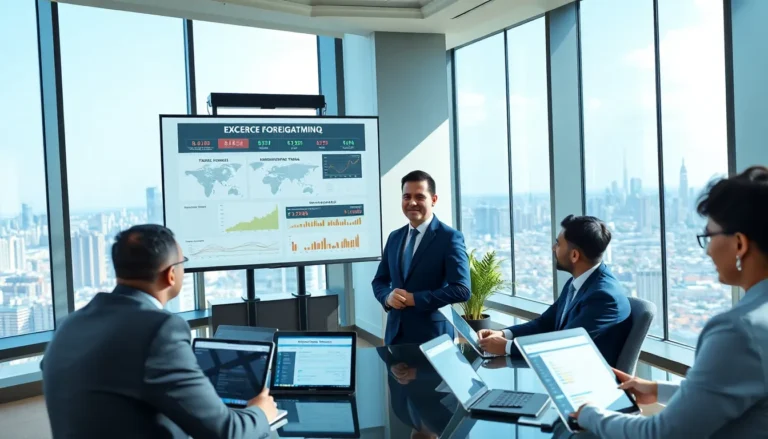Table of Contents
ToggleEver stumbled upon a term that sounds like it belongs in a sci-fi movie but is actually quite relevant to today’s world? Welcome to the fascinating realm of foreignatminq. You might think it’s a typo or an avant-garde dish at an upscale restaurant, but believe it or not, it’s more than that. Let’s jump into this intriguing concept, exploring its ins and outs while ensuring you’re entertained, but also enlightened. So, strap in, and let’s unravel the mysteries of foreignatminq together.
What Is Foreignatminq?

At its core, foreignatminq refers to the intricate processes and systems involved in the exchange of goods, services, and capital across international borders. It encompasses a vast array of activities and regulations that govern how nations interact economically. In other words, it’s the glue that binds global trade together, making it possible for countries to exchange their unique products and services to meet consumer demands everywhere. This phenomenon is crucial not only for fostering international relations but also for promoting economic growth and development.
In the modern world, understanding foreignatminq is becoming increasingly essential, as globalization continues to shrink borders, and shift the dynamics of economic power. Think of it as the handshake that happens every time you order a foreign delicacy or purchase a gadget made continents away.
So, whether you’re a curious observer or a student of economics, foreignatminq is a topic worth exploring. Let’s take a closer look at its historical context and development.
Historical Context and Development
The roots of foreignatminq can be traced back centuries. Ancient civilizations were already engaged in trade long before the term was even coined. From the famed Silk Road connecting East and West to the spice routes that fueled European exploration, trade has always served as a lifeline for cultures seeking resources unavailable in their homelands.
The evolution of foreignatminq accelerated significantly during the age of colonialism in the 15th to 19th centuries. Nations expanded their empires, establishing trade routes and developing complex systems of commerce that fundamentally changed global interactions. Fast forward to the 20th century, and we see the rise of international organizations like the World Trade Organization (WTO), founded to regulate and expand international trade agreements.
In essence, foreignatminq has evolved from simple barter systems to complex agreements and treaties. The impacts on society, politics, and economics continue to shape our global community today.
Key Components of Foreignatminq
Several key components define foreignatminq, making it a multifaceted phenomenon. Understanding these components provides insight into how countries navigate their economic interactions.
Trade Agreements
Trade agreements are the contracts forged between countries that outline the terms of trade. These can range from free trade agreements (FTAs) that reduce tariffs, enhancing trade relations, to customs unions that standardize regulations across member countries.
Currency Exchange
Foreign currency exchange is another vital aspect, as it determines the value of one nation’s currency against another. Currency fluctuations can significantly impact trade costs and profitability.
Regulatory Standards
Each country has its own regulatory standards that govern what can be exported or imported. These standards ensure that products meet safety, health, and environmental requirements, but they can also create barriers to trade.
Transportation and Logistics
Last but not least, transportation and logistics are crucial for successful foreignatminq. Efficient transportation systems ensure that goods move smoothly between countries, reducing delays and enhancing trade efficiency.
Impact of Foreignatminq on Global Markets
Foreignatminq significantly influences global markets in various ways. Let’s break down some major impacts:
Economic Growth
Firstly, it promotes economic growth by allowing countries to specialize in the production of goods for which they have a comparative advantage. This specialization leads to increased efficiency, innovation, and wealth creation.
Job Creation
As markets expand through foreignatminq, jobs are created both in international trade sectors and within businesses that rely on imported goods. Companies often experience growth in their workforce due to increased demand for international products.
Cultural Exchange
Also, this phenomenon fosters cultural exchange, as goods and services reflect the diversity of the countries involved in trading. Consumers benefit from a broader range of options, enhancing overall quality of life.
But, it’s not all sunshine and rainbows. Foreignatminq also poses challenges that require careful management.
Challenges and Criticisms of Foreignatminq
Even though its benefits, foreignatminq faces several challenges and criticisms:
Economic Disparities
One major criticism centers around economic disparities. Wealthier nations often dominate the foreignatminq landscape, making it harder for developing countries to compete. This can exacerbate existing inequalities between nations and within local economies.
Regulatory Conflicts
Another challenge arises from regulatory conflicts between countries. Different safety and quality standards can lead to trade disputes that slow down transactions and hinder cooperation.
Environmental Concerns
Environmental impacts cannot be ignored either. The increase in transportation and production activities can lead to pollution and resource depletion, raising ethical questions about sustainability in foreign trade practices.
Future Trends in Foreignatminq
Looking ahead, several trends are poised to shape the future landscape of foreignatminq:
Digital Trade
The rise of digital trade is one significant trend. As e-commerce continues to flourish, more businesses are looking to expand their reach internationally through the internet, thereby changing how foreignatminq operates.
Sustainability
Sustainability is another focal point. As global awareness of climate change increases, there’s a push towards sustainable practices in international trade. Businesses are expected to incorporate environmentally friendly practices and adhere to ethical standards.
Geopolitical Factors
Also, geopolitical factors will continue to influence foreignatminq. Trade wars, tariffs, and changing political climates can rapidly alter the landscape, making adaptability crucial for businesses engaging in international trade.




